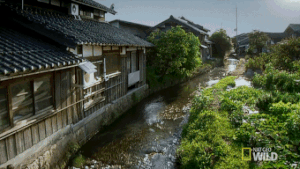Kabata is the culmination of the Japanese way of sustainable exploitation of freshwater resources. In this system, there is no dirt, no cleaning chemicals, but only fat carp.
In Japan, about a third of all fresh water goes to rice fields. For an island nation, fresh water is a really valuable resource. Even from ancient times, people in the land of cherry blossoms have been aware of this and the ancient water purification system called Kabata is the culmination of the way of sustainable exploitation of freshwater resources of the ancient Japanese.

Referring to the Kabata water purification system , the best example at the moment is Harie village, a small village located on the edge of the alluvial area next to Lake Biwa, the largest freshwater lake in Japan, in Shigai Prefecture. In this village, the water source from upstream will be channeled into a system of interconnected canals that extend to the residential area, which is part of the Kabata system mentioned at the beginning of the article. Thanks to the canal system, water will be directed into each house, but more specifically to a separate room in the house (also part of the Kabata system), dedicated to washing food as well as dishes. chopsticks after eating.

The water in this room will be stratified according to the level of cleanliness. Specifically, the water that flows from the pipe down the small stone sink will be the purest; When the small sink is full of water, it will overflow into the large sink below, occupying about 1/2 or 1/3 of the room, which is also the least clean place to store water. Depending on the purity, the purpose of use of the water layers is also very different. Specifically, the tap water will be used for drinking; water in a small tub used for cooling, washing vegetables, washing rice and rinsing washed dishes; The water in the large sink will be used to wash dishes and utensils with more dirt. Besides, because the water in the Kabata system is always kept at a temperature of 13-15 degrees Celsius all year round, it is also used by people to cool and preserve food in the summer. The fact that people often wash in this water source will make it dirty. But not! The water in the Kabata system is always in a clear state and this is also a special feature of this system.

Besides the reason for the constant flow of water, the key factor contributing to keeping the water clean is a special cleaning army: Carp . Accordingly, the carp are raised right in the large water tank of each house, when the owner washes the dishes, they will focus on and eat up the leftovers that fall to the bottom. Thanks to this solution, the carp both have food, and the water source is always kept clean. Thus, in the Kabata system there is no dirt, no cleaning chemicals, but only fat carp.

Following the flow of the Kabata system, the water from the large tank will mix into the canal system and the final destination will be the rice fields, a part of which is poured into Lake Biwa, the water is still in very clean condition. It can be said that with Kabata, everyone benefits.

